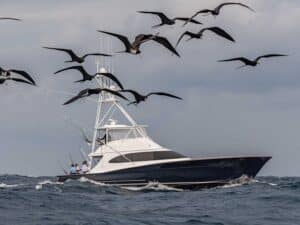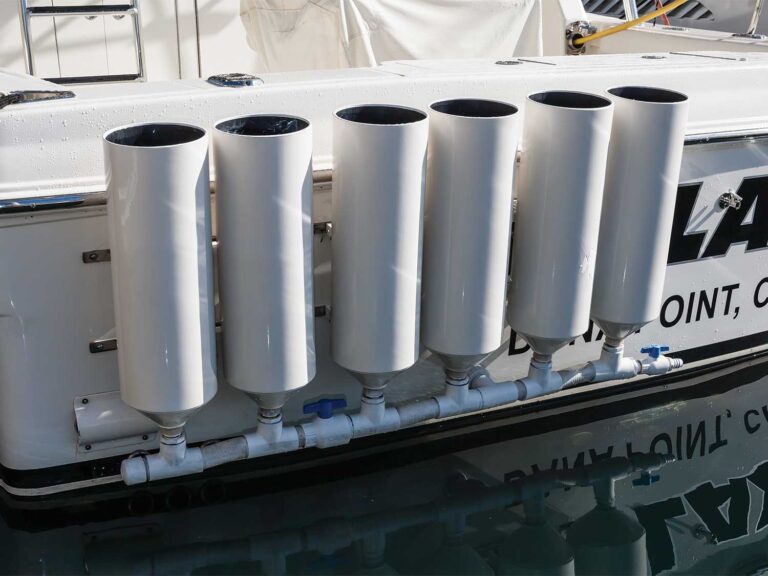
There are countless variables that must all come together to make a truly great sailfish bite. Water color, clarity, depth, wind and current direction and velocity, and presence of bait play a huge role, but most important, there must be sailfish.
Sometimes, even when conditions seem perfect — the water is clear and moving, the bait is everywhere — the sailfish are nowhere to be found. This is also true of the opposite: The water is green and stagnant, but the fish are biting well.
Being a charter captain and mate for the past 25 years has enabled me, for the most part, to find and stay with the bite. Having experience will undoubtedly make your backyard conditions easier to predict, but today, even weekend fishermen can keep up with who caught what and where. I’ll admit, I have spent my fair share of time on social media looking for a fishing report, and knowing the value of when and where the most favorable conditions might present themselves is an important asset for the weekend fisherman and the professional captain.
Two years ago in November, my son James and I watched for several days as a set of perfect water conditions began to materialize and drift up the line toward Miami. A strong cold front was predicted to arrive late on Sunday, and we knew that Monday would be the day. The strong current and a beautiful powder-blue edge we had been tracking had drifted about 20 miles from where we had first seen it, so Monday morning we knew exactly where we needed to be. We caught 31 sails that day off Miami Beach.
Free-Jumper!
Capitalizing on free-jumping sailfish can be an instrumental part of your day’s success, whether in a tournament or not. They only jump at certain times of the year, and there are a million theories why. My personal opinion is that sails free-jump as part of their spawning behavior. More often than not, when I pull up on a flopper, there will not be just one fish but sometimes a whole pack of them.
One flat-calm day, in gin-clear water, we spotted a free-jumper off Key Biscayne. I leaned on the throttles and raced my 46-foot Hatteras, L&H, into position. As the first baits went out, they were immediately eaten. From the tower, I looked through the water, and as far down as I could see, there were at least 40 to 50 fish, all in one tight pack. It was by far the largest group of sails

I had ever seen together at one time off South Florida. The point is this: The only reason I found them was because one of them jumped.
This is where experience, confidence and tactics come into play. So, before you get up and move, there are several things to consider when attempting to set up on a flopper: wind and current — both in direction and velocity — how aggressively the fish have been feeding, how fast they are moving, what bait we are using, how fast can I get there and how many other boats are baiting the same fish. Without at least considering these factors, you are throwing darts in the dark.
Realizing that sailfish swim into the current, you need to know the fish’s direction and speed. Stop short, and it’s likely they will swim in front of you. Go too far, and they probably have changed direction and didn’t see your bait at all.
This is why all the variables must be considered. It’s like a crazy math equation, and the only correct answer is a bite, rewarded with a release.
Too deep, or not too deep?
In Miami, the majority of our sails are caught in 90 to 180 feet of water, more or less just outside the reef. If you see an edge, weed line, bait getting up or anything at all, for that matter, that might signal the presence of sailfish, that is where you want to be. It is important to remember that there are no fences, and the fish are where you find them. I have caught countless sails in water only 10 to 20 feet deep simply because I either saw them swimming or showering ballyhoo. What about out in the deep? We have caught them there too. Is there such thing as too deep when targeting sails with live bait? Not at all. Don’t ever be afraid to try offshore, especially if the right conditions are there.
Several years ago, I was fishing in a two-day sailfish tournament off South Florida with my family. We were shut out the first day and had quite a hole to come out of. The second day greeted us with strong east winds, and I decided to look for sailfish offshore to get away from all the other boats.
We set up in 600 feet of water off Miami, and we stayed there all day. Our team ended up releasing two quads, a tripleheader and a doubleheader, good enough to put us into first place in the tournament. It was one of the best comebacks I have ever been a part of, and by the end of the day, most of the fleet was sitting in 600 feet — right next to us.







